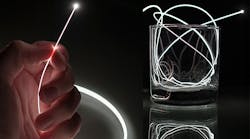Optical fibers typically deliver light from point A to point B over long distances—they’re not really considered for the formation of an extended illumination source. However, that’s about to change. By leveraging glass optical fiber and laser diodes, a new technology provides a unique, flexible light source that maintains bright and uniform light.
The Corning Fibrance Light-Diffusing Fiber, developed via a joint effort between Osram Opto Semiconductors and Corning Incorporated, is small and thin, allowing it to curve, wrap, and contour around objects. The fibers disperse, rather than transfer, light, allowing it to emit vibrant colors (using blue and green laser diodes) up to 50 m.
According to the research team’s whitepaper1, the fibers are about the same size as normal silica transmission fibers—the glass core diameter varies from about 100 to 200 μm and the polymer-clad thickness is ~50 μm. This makes the outer diameter of the fiber less than 150 to 250 μm.
The extraction of light from the fiber is uniform, and can be tuned to scatter light through the sides by controlling the number of scattering sights within the fiber’s core. The emitted light can also be converted to different colors through the use of phosphor coating. Glass cladding the fiber enhances efficiency of high-power or ultraviolet (UV) wavelength emissions. Furthermore, the fibers can be bundled together to increase the core size to essentially couple light from LEDs and similar light sources.
Watch a video from Corning on the Fibrance Light-Diffusing Fiber below:
Due to their flexibility, the fibers are able to be deployed in complex configurations and shapes for special lighting applications, especially where space is an issue. Light from the fibers can further be coupled into glass sheets for illumination purposes, providing a black light unit (BLUE) for LCD displays. The addition of a yellow phosphor on the fiber’s surface brightens white colors, pushing the fiber’s total brightness to over 10,000 lux.
References:
Stephan Logunov, Ed Fewkes, Paul Shustack, Fred Wagner. “Light diffusing optical fiber for Illumination.”Corning Incorporated. 2013.
